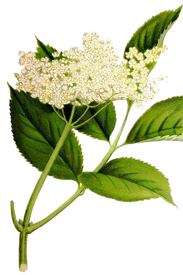Herb Article
Elder
By Faith Goguen
 Elder, Sambucus nigra
Elder, Sambucus nigra
Parts Used: Flowers & Berries
Medicinal Properties
The Elder tree, Sambucus nigra, is native to Europe. This is the variety that is used in most medicinal preparations that you will find in commerce. There are several other varieties of Elder, some native to North America including S. canadensis and S. racemosa. Elder is a small shrub or tree with cream colored umbels of flowers that bloom in the early spring and blue, dark purple or black berries that fruit in the early autumn. All the blue and purple-berried varieties are edible, but there is one red-berried species that can be toxic.
The history of the Elder tree is rich with folklore and magic. In rural England, Elder was believed to be inhabited by a powerful female spirit called the "Elder Mother". If someone wanted to harvest from the Elder tree it was necessary to say a prayer, ask permission and give an offering to the mother spirit or you might incur her wrath. The Elder tree was also considered a "gateway" to the underworld, symbolic of birth and death. You will often find it planted in cemeteries to help the deceased pass safely into the next realm and also in front of homes for protection from evil spirits.
The Elder tree has been used as medicine and as food throughout history. The flowers are bitter, cooling, astringent, decongestant, and relaxing. The berries, rich in vitamins A & C and bioflavanoids, improve digestion, build the blood and are antiviral. The fresh berries are a nourishing food that can be eaten in pies, jellies, and syrups. Elder has been in the spotlight in the last couple of years as people have been rediscovering its amazing ability to treat colds and the flu. The flowers make a wonderful remedy for fevers. A fever is one of the body's natural defenses to fight off infections. Elder flowers support the body's natural fever cycle by warming up the body and inducing a sweat that will eventually break the fever. They are very gentle and therefore can be given to elders and children. The berries act as an anti-viral for prevention and also lessen the severity and duration of an illness once it has taken hold. Elder is very diuretic, so it is important to drink plenty of water when taking it in order to avoid dehydration.
Preparations
Flowers: tincture or tea of the dried flowers
Berries: tea of dried berries, tincture, or syrup of fresh or dried berries
Recipe
Elder Berry Syrup
1 cup Elder berries (4oz net wt)
4 cups water
1 cup Honey
Combine berries and water in a saucepan, covered. Bring it up to a boil and down to a simmer. Simmer until the mixture is reduced by half the volume. Strain the elder berries out. Combine the leftover liquid (about 2 cups) with 1 cup of honey. Bottle, store in fridge for longest shelf-life.
Yields: 24 fl. oz of syrup.
Sources:
Encyclopedia of Herbal Medicine by Andrew Chevallier
The Book of Herbal Wisdom by Matthew Wood
The Desktop Guide to Herbal Medicine by Brigitte Mars




